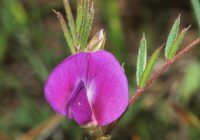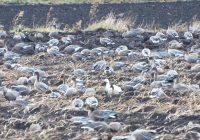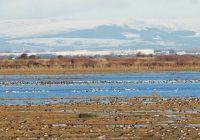Dr Phil Smith’s Wildlife Notes
November 2014
This was another exceptionally mild month with mean temperatures about 1.3oC above normal. Disappointingly, our region was also the driest in Britain and Ireland with only 78% of average rainfall, meaning that hardly any slacks were flooded by the month’s end. Not good news for our local Natterjack recorders who assembled for their annual meeting on 19th. Results had been mixed earlier in the year with some sites, especially the recently dug scrapes, reporting good breeding success, while many others had dried up prematurely. Plenty of winter rainfall is the key to suitable breeding conditions the following season.
My priority during the first half of November was to map and measure bushes of the hybrid willow Salix × friesiana most of which were last surveyed in 2009. A few had died but others had grown up from seed, my final total being 414 bushes. This is a great rarity nationally, with only a handful of specimens known in about six other British localities. My data formed the basis of a scientific paper which was submitted for publication at the end of the month. While searching for willows, I was delighted to find two new colonies of Autumn Gentian in Birkdale slacks, totalling 210 and 65 spikes respectively.
The “buckthorn bashes” continued with two more events during the month. Including the October sessions, a total of 26 local volunteers turned out to clear Sea Buckthorn from about 4.8 ha of dunes and slacks near Sands Lake, Ainsdale. Here, John Dempsey showed us the rare and specially protected Petalwort (a tiny liverwort) on the edge of slack 50. There wasn’t time for much botanising but the mild conditions meant a great range of plants were still in flower. Without trying too hard, Patricia Lockwood and I found blooms on Common Vetch, Blue Fleabane, Round-leaved Wintergreen, Red Clover, Mouse-ear Hawkweed, White Dead-nettle, Cat’s-ear, Lesser Hawkbit, Large-flowered Evening-primrose, Creeping Buttercup, Hemlock Water-dropwort and Hogweed, as well as the ubiquitous Common Ragwort. None of these would survive if Sea Buckthorn took over.
The unseasonal warmth also contributed to a brood of four recently hatched Mallard ducklings on Sands Lake. More typical were a Water Rail calling from the surrounding reed-bed, while wintering ducks included 30 Tufteds and two Shovelers. Not far away, it was pleasing to see pairs of Stonechat on the Green Beach and near Pontin’s. A large flock of Pink-footed Geese on Downholland Moss was joined for a day or two by a Lesser Snow-goose, its strikingly white plumage making it easy to spot even from a distance of 200m or more. The origin of Snow-geese in Lancashire is always problematic as they are liable to escape from collections. However, at least some individuals may be wild birds from their breeding range in Arctic Canada.
Although two Ravens over my flat and a Red Squirrel in the carpark were nice, easily the best find of the month was a stunning Great Grey Shrike spotted by Tim Vaughan near Cabin Hill on 3rd. I dashed down to see it actively flying between fence posts and bushes, characteristically perching high up. It even flew onto Cabin Hill National Nature Reserve, so could be counted for the reserve list. It is over 30 years since I last saw one of these birds locally. On the same day, one was reported at Lytham St. Anne’s but this Northern European migrant is much more likely to be found along the east coast of England.
Marshside is usually worth a few visits in November and did not disappoint on 26th when at least 10,000 Wigeon were crowding the tide edge, while a ghostly grey male Hen Harrier performed spectacularly near the coast road. Returning four days later, I was surprised to see a Stoat swimming across a channel near the main hide, while an enormous flock of waders on Crossens Reclaimed Marsh included an estimated 1100 Black-tailed Godwits, 2000 Lapwings and 1500 Golden Plover. What a sight!




